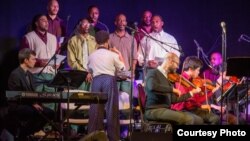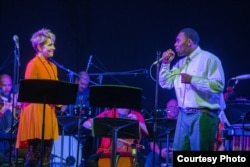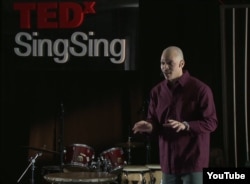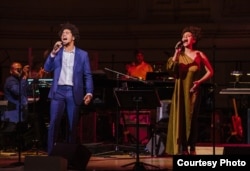Sing Sing Correctional Facility, a maximum security prison about an hour north of New York City, holds some 1,600 inmates; but, even as the men serve their sentences, prison officials are thinking about — and planning for — the day those inmates will be released.
The deputy superintendent for program services, Leslie Malin, says the prison offers technical workshops and academic courses. "We have an associate's degree program, a bachelor's degree program, a master's degree program."
And it has a music program, in cooperation with the famed Carnegie Hall concert venue.
Making musical connections
Twice a month, artists from New York City travel to Sing Sing and spend a day giving the 30 inmates enrolled in the Musical Connections program formal training. Before it started nine years ago, Sing Sing had a music room.
But one former inmate, identified only as Rob, says there were often fights over who could use it. The Department of Corrections asked that we not use any last names or say what brought these men to prison.
"Where we had fragmented fighting groups, now all these guys are part of this weird cohesive thing, where we have to play together and we're, all of a sudden, we're doing the instant duet, me and somebody who hates me. But we're communicating musically." Rob paused and asked, rhetorically, "How long can we go on hating each other when we're helping each other with the score or sharing a piece of music and we're all kind of struggling to keep up, you know, with everybody else?"
Rob has been on parole for the last year-and-a-half, after spending seven years in Sing Sing. He played just two open mics before he went to prison.
Joe had even less experience.
"I didn't know what an A flat was," he acknowledged. "I've heard these terms. I couldn’t have explained them to you. I didn't know what they sounded like. I didn’t know what they meant."
But after four years in the program — studying music theory and harmony — Joe is writing an opera. He became interested in classical music after working with opera star Joyce DiDonato.
"She definitely opened my eyes to something that I didn't even know I had within myself," he said.
Scaling up skills
Kenyatta, who has been incarcerated for 23 years, calls the program "the most transformative thing I've ever experienced." Kenyatta has earned a master’s degree in divinity and given a TED talk from Sing Sing. He has been a part of the music program since it started and says the craft has helped him open up to others.
"Then I can be a little less alone, because I know you understand some part of me, at least, and you can be a little less alone because you know that I understand some part of you," he said. "And this really has been pivotal in helping me."
Listen to Kenyatta introduce and sing his composition 'Holding Out Hope'
The Musical Connections program is run by Carnegie Hall’s Manuel Bagorro, who oversees similar programs in shelters and community centers.
"People have come together; they play together. They negotiate artistic decisions," he said. "They sort out problems, but all with enormous affection for music."
And those are all skills that inmates can use on the outside. Danny was released from Sing Sing three-and-a-half years ago, after seven years in the prison system. He learned to play the violin in the Musical Connections program and started writing music.
"After being released from prison, I was able to take that same drive and the same dedication that it takes to learn a musical instrument and to compose, into other areas of my life," he said.
Take a behind the scenes look at music at Sing Sing
One of the teaching artists, Sarah Elizabeth Charles, says she has seen both personal and musical growth in the prisoners over the years.
"I just think the sky's the limit for so many of the men in this workshop. They're professional. They're working. Many of them are working on the level of a professional musician. And that's really huge. Yes. Sky's the limit," she added with a laugh.
Music lessons
For the members of the workshop who have been released from Sing Sing, Carnegie Hall hosts a monthly gathering. Rob says the men in the alumni group don’t just play music when they get together – they talk about what’s going on in their lives.
"It showed me that everybody was struggling trying to find a job, trying to stay employed, trying to find time to practice in this hectic life," he said. "I knew I wasn't alone in any of those things."
And like other members of the Musical Connections program who are out of prison, Rob has been getting his life together – he’s working as a bike messenger, is now married and plays various musical gigs around town.








